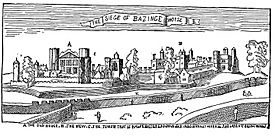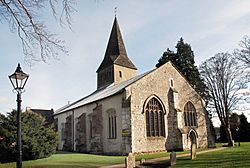Westminster Trained Bands facts for kids
Quick facts for kids Westminster Trained Bands |
|
|---|---|
| Active | 1572–1662 |
| Country | |
| Branch | |
| Role | Infantry |
| Size | 1–2 Regiments + 1 Troop of Horse |
| Part of | Middlesex Trained Bands |
| Garrison/HQ | Westminster |
| Engagements | Siege of Basing House Battle of Alton Battle of Cropredy Bridge Second Battle of Newbury |
| Commanders | |
| Notable commanders |
Sir James Harington, 3rd Baronet |
The Westminster Trained Bands were a part-time army group formed in 1572. They were made up of people living in the City of Westminster. These groups were part of the bigger London Trained Bands. They were called into action when needed for home defense, like during the 1588 Spanish Armada attack.
Even though they were mainly for London, the Trained Bands became a big part of the Parliamentarian army. This happened in the early years of the First English Civil War. After the New Model Army was created in April 1645, they went back to their main job. This was protecting the palaces of Westminster and Whitehall. After the king returned in 1660 (the Stuart Restoration), a new law in 1662 put them under the king's direct control. The Trained Bands then became part of the British Army.
Contents
What were the Trained Bands?
The idea of a local army in England came from the old Anglo-Saxon Fyrd. This was a military force made up of free men from each area, led by their local leader, the Sheriff. This system continued under later kings. Laws in 1557 updated how these local armies were organized. Each county's local army was now led by a Lord Lieutenant.
It was not practical to train every able-bodied man. So, after 1572, only a part of the men were chosen for the Trained Bands. These chosen men would gather for regular training. The City of London, Westminster, and Tower Hamlets had their own local army groups.
The Armada Crisis of 1588
In 1588, when the Spanish Armada threatened England, the Trained Bands were called up. The Westminster group included men from several areas:
- City of Westminster
- St Giles-in-the-Fields
- St Martin-in-the-Fields
- High Holborn
- Gray's Inn Lane
- St Clement Danes
- The Savoy Parish with the Strand
This group had 150 pikemen (soldiers with long spears) and 300 calivermen (soldiers with early guns). They were ready to fight within an hour's notice in June. They were called out on July 23 as the Armada got closer. But they were quickly sent home once the danger was over.
Later, the Trained Bands became less active. King Charles I tried to make them a national army that answered to him. In 1638, the Middlesex Trained Band had 928 musketeers and 653 pikemen. They also had 80 horsemen. They were called upon in 1639 and 1640 for the Bishops' Wars. However, many men who went were untrained people hired to take their place.
The Civil War Begins
Control of the Trained Bands was a big disagreement between King Charles I and Parliament. This disagreement helped start the English Civil War. When King Charles I returned in 1641, he wanted to change the guards protecting Parliament. These guards were from the city and nearby areas.
The Westminster Trained Bands were already providing guards for Parliament. Many of their members worked for the Royal Court. There were clashes between the guards and young apprentices. However, the Westminster Trained Bands later showed their loyalty to Parliament. Their Royalist officers were removed.
Westminster's Red Regiment
At this time, the Westminster Trained Bands were still under the local leaders of Middlesex. They included areas like St Martin-in-the-Fields and St Giles in the Fields. Together, these groups formed the Westminster Liberty Regiment. It was also known as the Westminster Red Regiment because of its red flags.
This regiment was led by Sir James Harington, who was also a Member of Parliament. His own company was recruited from around Temple Bar. Other companies came from the Parish of St Margarets, which included the Palace of Westminster.
In August 1642, the Westminsters searched houses for people against Parliament. They arrested some Roman Catholic priests. When the war started, most local armies were not used much. But the large, well-trained regiments in London supported Parliament. They helped turn King Charles away from the city at the Battle of Turnham Green in November.
London's Defenses: The Lines of Communication
London had grown much bigger than its old city walls. After the Battle of Turnham Green, citizens built defenses across streets. During the winter of 1642–3, volunteers built a huge wall and ditch around the city and its suburbs. This included all of Westminster.
These defenses were called the Lines of Communication. They had about 23 forts and strong points. They were about 11 miles (18 km) long, making them the biggest city defenses in 17th century Europe. The Lines were finished by May 1643. The city and suburban Trained Band companies took turns guarding these forts.
To help guard these long lines, each London Trained Band regiment raised an "Auxiliary" regiment. Westminster also raised its own Auxiliary Regiment in April 1643. This regiment was known as the Yellow Auxiliaries.
In August 1643, the London Militia Committee took control of all the Trained Bands inside the Lines of Communication. This committee controlled 18 regiments of Foot soldiers, about 20,000 men in total. Not all could be called away at once. They needed to guard the defenses and keep the city's economy going.
The Westminster Liberty Regiment was one of the strongest. It had 2018 men in September 1643. Some London regiments took part in the relief of the Siege of Gloucester. They also fought in the First Battle of Newbury on their way home. The Westminster Liberty Regiment was later assigned to Sir William Waller's army.
Battles: Basing House and Alton

Harington's brigade, which included the Westminster Liberty Regiment, joined Waller's army in November 1643. They moved to attack Basing House. The Westminster Trained Band musketeers had trouble with their firing drill. Many front-rank men were killed or wounded by their own side firing too soon. With Royalist cannons firing at them, the Westminster musketeers ran away, and the attack failed. Many Westminsters deserted, but they were fined or jailed when they got home.
The London regiments wanted to go home. Waller then marched to Alton, Hampshire, where part of the Royalist army was staying. Waller's soldiers attacked the town by surprise. The Westminsters helped attack a defense wall. Some London musketeers broke in and pushed the Royalists back into St Lawrence's Church. The Royalists surrendered after their colonel was killed. After the Battle of Alton, Waller returned to Farnham. The London Brigade refused to fight more and was allowed to go home on December 20.
Oxford and Cropredy Bridge
Parliament wanted to gather all their armies to attack Oxford. A new London brigade was formed, including the Westminster Yellow Auxiliaries. They joined Essex's army and Waller's army. The Royalist army left Oxford.
The two armies followed the King's force. Waller's army fought the King's army at the Battle of Cropredy Bridge. The Tower Hamlets Trained Bands bravely defended their side of the bridge. They stopped the Royalists from crossing and destroying Waller's army.
After this battle, Waller's London brigade wanted to go home. They were finally allowed home on August 14. Meanwhile, the King's army trapped and captured Essex's army at Lostwithiel.
The Second Newbury Campaign
Parliament ordered a new gathering of forces to face the King's army. London provided a fresh brigade of five regiments, led by Harington. This included the Westminster Red Regiment.
The London brigade was late in getting ready. But Harington marched out with the Westminster Red Regiment (over 1900 strong) on October 7. On October 26, the combined Parliament forces met the Royalist army at the Second Battle of Newbury. The London brigade was with Essex's army. Harington had his horse shot from under him during the battle. Some cannons lost at Lostwithiel were recaptured. However, the Royalists managed to escape.
Changes and Reorganization
The Second Newbury campaign was the last time the City and Suburban regiments saw active war service. In 1645, Parliament created the New Model Army. This was a well-paid, equipped, and trained army for service anywhere. This strong force meant London no longer needed to send brigades to the field.
The Trained Bands continued to guard the city and train. In May 1646, all 18 City and Suburban regiments paraded in Hyde Park. But the First English Civil War had ended. The Westminster Yellow Auxiliaries also lined the route for the funeral of the Earl of Essex in October.
By 1647, control of the English Trained Bands became a problem between Parliament and the Army. The Army saw the Trained Bands as a backup force. Parliament passed new laws that put the local armies under commissioners appointed by Parliament. The London Militia Committee tore down the Lines of Communication. The suburban Trained Bands went back under local control.
Under the Commonwealth and Protectorate, the local army groups were paid when called out. They worked with the New Model Army to control the country. During the Worcester campaign in 1651, the Middlesex Militia was ordered to gather at St Albans. The London Trained Bands stayed to guard London.
Middlesex Militia
After the king returned (the Restoration of the Monarchy), the English local army was started again. This was done by the Militia Act of 1661. It was under the control of the king's local leaders. Men were chosen by a lottery system. This force was seen as a way to balance the "Standing Army," which had supported Cromwell's rule.
The Middlesex Militia now included the Red Regiment of Westminster. It also had the "Blewe" (Blue) Regiment of Middlesex and the Westminster Troop of Horse. These groups continued until at least 1728. The local army was reformed in the 1750s. A new Royal Westminster Militia was created.
Uniforms and Flags
The Westminster Company's flag in 1588 was described as having large squares in blue and gold. It also had a cross of St George on a white band at the top.
The Trained Bands did not seem to have uniforms. Their regimental names came from the colors of their company flags. The Westminster Liberty Regiment, or Red Regiment, carried red flags. The seniority of the captains was shown by silver stars on the flags.
The Westminster Auxiliaries were known as the "Yellow Auxiliaries" by 1644 because of their yellow flags. Before that, they might have had blue flags. Seniority was shown by flames coming from the corner of the Cross of St George on the flag.
|
See also
- Trained Bands
- Middlesex Militia
- Royal Westminster Militia




